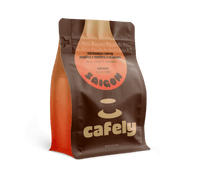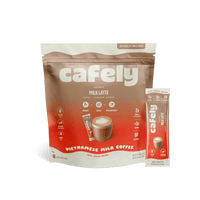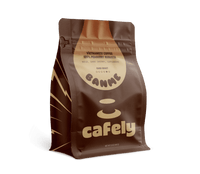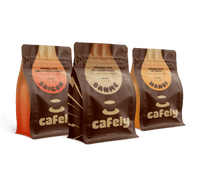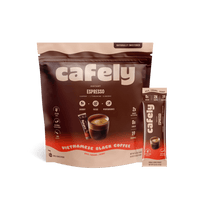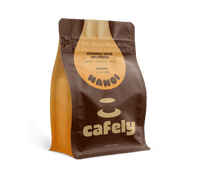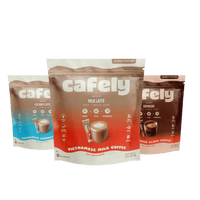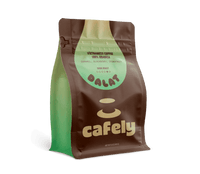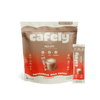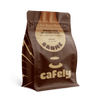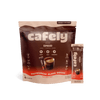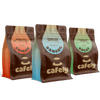Even those devoted to strong, black coffee can have a moment now and then when they'd like to indulge their sweet tooth. However, you may feel that sugar's too unhealthy for you or that the flavor is a bit too simple.
We will run through some of the best ways to sweeten coffee, including one of our favorite options, the Cafely Vietnamese Coffee 2.0 Instant Espresso, sweetened with all-natural monk fruit instead of sugar.
We’ll also take a closer look at some of the most popular sugar alternatives that will help make every brew perfectly sweet.
How to Sweeten Coffee Without Sugar
Sweetening coffee without sugar is far easier than it may sound at first.
Plenty of unique ingredients can make your coffee a sweet, delectable treat.
Alternatively, choosing coffee that's sourced and roasted to perfection, like Cafely’s Vietnamese Coffee Collection, can provide enough natural flavor and sweetness on its own.
Add Natural Alternatives

A great first choice is to add a natural sweetener, like monk fruit, honey, or maple syrup. These sweeteners are very sweet, but they also have delicious and complex underlying flavors.
One main reason to use natural sweeteners instead of sugar is that they often provide additional health benefits.
Monk Fruit
Monk fruit comes from Siraitia grosvenorii, a plant native to Southeast Asia. Unlike chemically-based sugar alternatives, monk fruit is natural. Monk fruit has zero calories and is intensely sweet compared to regular sugar.
Because of its high potential for assistance with weight management, monk fruit is often used as a standalone sugar alternative.
If you're new to monk fruit, we highly recommend the Cafely Vietnamese Coffee 2.0 Instant Milk Latte, which provides barista-quality coffee anywhere — without any added sugar.
Honey
Honey can have a wide array of flavor profiles, from mild and floral to complex and robust. It's known for having floral, fruity, and even warm caramel or butterscotch notes.
This allows you to craft a coffee drink that's not just sweet but complex and rich, too.
Honey also has a lower glycemic index compared to regular sugar, which can help maintain healthy blood sugar levels.
Overall, honey is tasty, helpful for your immune system and digestion, and provides an incredible range of natural flavors to enjoy in your coffee.
Maple Syrup
Maple syrup has a rich, sweet, caramel-like flavor with hints of butterscotch, vanilla, or toffee. Like honey, maple syrup has a lower glycemic index than sugar and is high in vitamins, minerals, and antioxidants.
Maple syrup also comes in an incredible assortment of flavors, though these might contain added sugar. Craft syrups can come in flavors ranging from gingerbread and peppermint to blueberry and apple cinnamon, expanding the taste profiles for your favorite coffee beverages.
Other Alternatives
While we’ve covered some popular options, there’s no shortage of alternatives to suit different dietary, lifestyle, or taste preferences.
Popular natural sweetener alternatives for coffee include:
- Agave Syrup — Produced from agave plants,agave nectar has a relatively sweet and neutral taste, making it easy to incorporate into coffee without overwhelming flavor.
- Golden Sugar — Thick, amber-colored syrup that is refined from sugar cane or beet juice and has a mild, buttery flavor.
- Molasses — Made from sugar cane or sugar beet juice and produces a distinctly sweet, brown liquid with a syrup-like consistency.
- Dates — Sourced from the date palm tree, these sweet, chewy fruits can be made into a thick paste and used as a one-for-one sugar replacement.
In addition to the tantalizing tastes that natural sweeteners can provide, they also significantly benefit your health and wellness.
Enjoy Extra-Strength, Zero-Added Sugar, Naturally-Sweetened Coffee!
Enhance Coffee’s Natural Sweetness
By selecting new additions to your coffee, you can enhance its natural sweetness. A common example is the addition of cinnamon — the natural sweetness and brightness of the spice can easily enhance your brew.
While others may prefer the deliciously iconic flavor of vanilla coffee creamer.
It’s also common to add flavors that, while not necessarily sweet, are associated with sweetness.
For instance, adding coconut flavor, like in Cafely’s Vietnamese Coffee 2.0 Instant Coconut Latte, can make the entire coffee experience feel a little smoother, sweeter, and more indulgent.
This may not work for everyone, but it's a common and effective trick you can play on your tastebuds.
How Natural Sweeteners Can Improve Your Health
Natural sweeteners have different nutritional and dietary profiles compared to granulated sugar. Often, using natural sweeteners in coffee can reduce the sugar you regularly consume, helping to lower glucose levels. This can be helpful for those looking to lose weight, for instance, or for diabetics.
They also often contain trace amounts of beneficial vitamins and minerals. A quick look at the nutrition label will tell you what you’re getting.
Additionally, people have long used locally sourced honey to counteract their seasonal allergies. This works because local bees interact with the same pollen as you, and it makes its way into their honey in very small amounts. Over time, the allergy sufferer can build up a tolerance to pollen.
When deciding on the right sweetener for you, consider any other health or wellness needs you may have, and select a sweetener that can help deliver those benefits.
Finding the Best Coffee for Natural Sweetness
It’s also important to remember that coffee can have plenty of natural sweetness. When coffee is roasted, a series of chemical reactions allow the compounds to both break down and combine, resulting in coffee’s aromatic compounds and specific flavor profiles.
Specialty Beans
It’s quite common for coffee enthusiasts to start their journey with drinks made with cream and sugar. Over time, coffee drinkers usually develop a taste for dark or medium roasts and their individual flavor profiles.
Through the tasting process, they find the natural sweetness of coffee beans to be much more complex, enjoying the nuances of the coffee itself. In turn, they may eventually forego cream and sugar entirely, landing on a specialty coffee that’s just sweet enough for them.
If you’re looking for a specialty coffee blend that balances sweetness and complex flavors, we’ve compiled a few core things to remember.
1. Organic
One of the key factors that drives sweetness in coffee is the speed at which the coffee cherries become ripe. If artificially forced to become ripe very quickly, they can have a less desirable flavor. If they're organically farmed in optimal conditions and allowed to ripen slowly, the beans will inherently have better flavor and more sweetness.
2. Roast

As coffee beans are roasted, the carbohydrates within them are broken down into simple sugars. Then, the Maillard reaction occurs, and the sugars combine with natural fats to caramelize. Generally, dark roast coffee features more intense, chocolatey flavors, while medium roast coffee can have fruity caramel notes.
3. Low Acidity
While there’s not a direct relationship between the amount of acid in a coffee and the amount of sugars, the acid in coffee can mask its sweetness. To ensure you're getting balanced sweetness, look for beans grown at low elevation and roasted dark. These beans will have less acid, leading to more sweetness.
4. Fair Trade
The Fair Trade program ensures that coffee farmers are fairly compensated for their hard work. Rather than rushing to harvest, farmers can allow the plants to take their time. This allows more time for ripening and, in turn, more time for the beans’ sweetness to develop.
5. Single Origin
While single-origin beans aren’t necessarily sweeter than other options, choosing single-origin coffee means you're more likely to get the same flavors between different batches. So, if you find a single-origin coffee you like, you'll likely enjoy it for a long time.
By choosing the right coffee to begin with, you can savor the natural essence of coffee, enjoying smooth flavors without any need for added sweetener.
Try the Best and Most Flavorful Fair Trade Ground Coffee Here!
Pre-Sweetened Drinks
While buying a pre-sweetened drink may seem like cheating, it can be a great way to ensure that your beverage is sweet enough without figuring out the perfect recipe. To find drinks that strike this balance well, look for options that use natural sweeteners instead of sugar.
For instance, a natural sweetener like organic monk fruit can have a delicate and complex flavor that enhances the coffee. Another benefit of drinks that use organic additives is that they may include useful adaptogens to benefit your morning routine. For instance, adding L-theanine can work synergistically with caffeine to enhance mental clarity.
When choosing pre-sweetened options, it's important to keep the calorie content in mind. A tall drink packed with sugar, syrups, and cream can drastically increase your caloric intake. Counter this by striking a balance between indulgent treats and more stripped-back options.
Changing Your Brewing Style
Brewing and roasting coffee are art forms. By saying this, we mean there's no exact way to do it, and the tiniest changes can have enormous impacts on the final product.
When brewing coffee for sweetness, it’s wise to opt for roasts that match the flavor profile you prefer. The best way to get the sweet notes into your drink is to grind the coffee very finely and brew it at a high temperature.
One of the best ways to combine these two is to brew your coffee as an espresso. Espresso shots are typically pulled with dark-roasted, fine-ground coffee, and the brewing water sits in the ideal range for sweetness — 194-214˚F [90-101˚C].
Other ideal ways to brew for sweetness are to use a phin for Vietnamese-style coffee or a moka pot, which is similar to espresso.
Dessert Coffee Drinks
If you're looking beyond just adding a little sugar to a cup of coffee, there are many ways to create tasty drinks that make for a wonderful dessert. We've picked three of our favorites that balance coffee's innate bitterness with creamy, smooth flavors.
Egg Coffee
There are actually two types of egg coffee, one from Europe and one from Vietnam. European egg coffee is a brewing method that involves cracking eggs into the coffee during brewing to add more smoothness. The Vietnamese option is what we’re after, and it’s a complex, delicious dessert drink that can be exceptionally indulgent.
The name is a bit misleading, and perhaps a better one might be "custard coffee." Essentially, Vietnamese Egg Coffee is a serving of strong, dark coffee with an egg-based topping made from eggs, sugar, and sweetened condensed milk.
These ingredients are whipped together to make a light, sweet, airy topping that floats on the coffee, like frothed milk. The idea is that by sipping slowly, you get a little of both the coffee and the topping in your mouth at once.
Vietnamese Coffee

Vietnamese coffee means different things to everyone, from just the beans themselves to the tradition of butter-roasting to a very dark level. In this case, however, we’re using it to refer to the rich, sweet drink made from dark roast robusta and sweetened condensed milk. Essentially, the drink is quite straightforward.
How to Make Vietnamese Coffee:
- Add the Milk — Typically, up to two tablespoons of sweetened condensed milk are added to the bottom of a heat-proof glass.
- Vietnamese Coffee Press — On top of the glass, a traditional brewer, called a Vietnamese coffee press or phin filter, is placed and filled with finely ground coffee and hot water.
- Brew — The brewing commences, and the coffee slowly drips out of the brewer and onto the milk at the base of the glass.
- Enjoy — After around five minutes, brewing is complete, and the dark coffee has been slightly mellowed with thick, creamy sweetened condensed milk.
You can even simplify the process of making Vietnamese coffee by choosing premium instant options, like Cafely’s Vietnamese Coffee 2.0, known for its premium quality without the extra effort.
Suggested: Unveiling the Health Secrets of Vietnamese Coffee
Affogato
Affogato is a traditional Italian dessert made with best espresso coffee and ice cream.
It's very simple — just place a scoop or two of ice cream into a heat-proof bowl and draw a shot of espresso directly onto it. The heat of the coffee melts some of the ice cream, leading to a tasty mixture of the two.
Vanilla ice cream is a popular choice since the flavor interacts well with the coffee, but feel free to experiment.
FAQs: How to Sweeten Coffee Without Sugar
Now that we've discussed some great options for sweetening coffee without sugar, here are some common FAQs.
1. How to Brew Coffee for Sweetness?
Brewing coffee for the most sweetness can be complex. It’s best to start with an organic, single-origin, expertly-crafted coffee with a sweeter profile, then brew at a slightly higher temperature than usual.
2. How to Get More Sweetness in Coffee?
To enhance the natural sweetness of coffee, you might consider adding spices like cinnamon and other flavorings like vanilla or milk that can mellow out coffee's bitterness. While this doesn't make the drink inherently sweeter, the new flavors can help to achieve a balance you may enjoy.
3. How Can I Make Coffee Taste Good Without Sugar?
A great way to ensure your coffee tastes as good as possible without sugar is to brew top-notch coffee. Specialty coffee is lovingly farmed and roasted to ensure it’s a premium product, and paying just a little extra compared to your usual brand can get you a delicious flavor upgrade.
4. What’s the Healthiest Thing to Sweeten Your Coffee With?
This is a tricky question since different sweeteners are usually healthy in slightly different ways, and "healthy" means something different to everyone. Many people like to use natural, organic honey as a sweetener — it can be just as sweet as sugar, if not sweeter, and it can help support your natural immune system, too.
5. What’s the Best Substitute for Sugar in Coffee?
If you’re looking for a sugar substitute for health reasons, you may be interested in natural sweeteners like organic monk fruit. Typically, these sweeteners are natural, plant-based alternatives that are low in glucose. This makes them ideal for managing one’s blood glucose levels, which can be very helpful for both weight loss and diabetes.
6. How Do You Sweeten Unsweetened Coffee?
The simplest way to sweeten unsweetened coffee is to add your own sweetener. A tasty option is maple syrup — it can have some naturally caramelized flavors that can match the natural sweetness of coffee, thereby enhancing it.
7. Is Putting Honey in Coffee Better Than Sugar?
Adding honey to your coffee is not necessarily better or worse than sugar, but it can make the natural flavors of the drink much more interesting. Natural, raw honey typically has complex fruity and floral flavors. Adding that to your coffee gives you a more complex sweetness than sugar.
8. What Do Diabetics Use to Sweeten Coffee?
Diabetics typically use any sugar alternative that is low in glucose. Diabetes is a condition that impacts your body’s ability to manage your blood glucose level, so reducing glucose intake is generally thought to be a good idea. Plant-based options like Stevia are popular.
9. What Is the Healthiest Substitute for Sugar?
While many sugar alternatives have the same calorie count as sugar, they can also possess additional benefits. For example, maple syrup contains antioxidants, iron, zinc, calcium, and potassium.
10. What Do Coffee Shops Use to Sweeten Coffee?
Coffee shops often sweeten their coffee with flavored syrups, such as the Fall classic pumpkin spice syrup. Using flavored syrups can enhance the coffee by adding not just sweetness but further flavor complexity.
